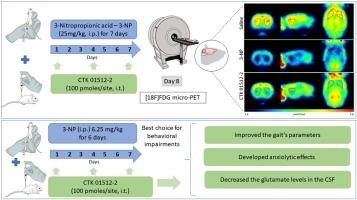Neuroprotective effects of the CTK 01512-2 toxin against neurotoxicity induced by 3-nitropropionic acid in rats |
| |
| Affiliation: | 1. Program of Postgraduation in Cellular and Molecular Biology Applied to Health, Lutheran University of Brazil (ULBRA), Canoas, RS, Brazil;2. Laboratory of Toxicology Research, The Federal University of Health Science of Porto Alegre (UFCSPA), Rio Grande do Sul, Brazil;3. Centro de Pesquisa Pré-Clínica, Instituto do Cérebro do Rio Grande do Sul, Brain Institute (Brains), Pontifícia Universidade Católica do Rio Grande do Sul (PUCRS), Porto Alegre, 90610-000, Brazil;4. Laboratory of Pharmacy, Lutheran University of Brazil (ULBRA), Canoas, RS, Brazil;5. Institute of Teaching and Research of Santa Casa de Belo Horizonte, Belo Horizonte, Brazil;6. Department of Chemistry, Lutheran University of Brazil, Canoas, RS, Brazil |
| |
| Abstract: | 
The mitochondrial inhibitor 3-nitropropionic acid (3-NP) induces excitotoxicity. The authors hypothesized that CTK 01512-2, a recombinant peptide calcium channel N-type blocker, and the TRPA1 antagonist, could show neuroprotective effects. The male Wistar rats received 3-NP [25 mg/kg (i.p.) for 7 days], and a treatment of CTK 01512-2 was delivered intrathecally (i.t.), thrice a week. The neuroprotective effects were evaluated by [18F]FDG MicroPET analysis. The CTK 01512-2 toxin was able to reestablish similar glucose uptakes on the control animals. To detect the neurobehavioral effects from 3-NP, three protocols (6.25, 12.5, 18.75 mg/kg of 3-NP (i.p.), for 3, 4, and 6 days, respectively) were evaluated by performance tests (open field test, walk footprint, elevated plus-maze, Y-maze, and the object recognition test). Important disabilities in the gait of the rats were seen, as well as memory deficits, and anxious behavior in the animals that were treated with all 3-NP protocols. The dose of 18.75 mg/kg (for 3 days) showed the most pronounced behavioral effects and lethality, while the rats treated with 12.5 mg/kg (for 4 days) showed behavioral effects similar to the 6.25 mg/kg dose (for 6 days). The third protocol was then repeated and the rats were treated with the CTK 01512-2 toxin to be evaluated behaviorally again. The recombinant peptide prevented all of the gait-evaluated parameters that were induced by 3-NP at a 6.25 mg/kg dose, which displayed an improvement in the exploratory activities. Overall, these results have reinforced the positive effects of CTK 01512-2 against the behavioral changes that were induced by the mitochondrial inhibitor 3-NP. |
| |
| Keywords: | Huntington’s disease Positron emission tomography Voltage-gated calcium channel Calcium signaling Cav2.2 |
| 本文献已被 ScienceDirect 等数据库收录! |
|

